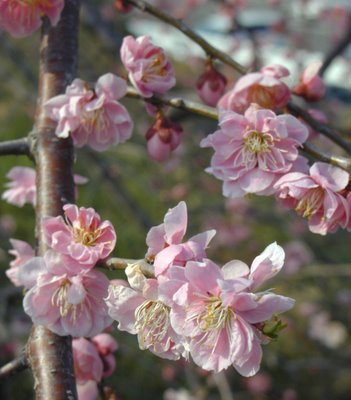::::::::::::::::::::::::::::::::::::::::::::::::::::::::::::::::::::::::::::::::::::::::::::::::::::::::::::::::::::::::::::::::::::::::::::::::::::::::::::::::::::::::::::::::::::::::::::::::::::::::::::::
- sumi 炭 charcoal -
Charcoal was important for heating and also for the tea ceremony.
Read first about the various kinds of charcoal in the Edo period :
. sumi 炭 charcoal in the Edo period .
kigo for all winter
Binchō-tan, binchootan or binchoo-zumi 備長炭 is a traditional white charcoal of Japan.

::::::::::::::::::::::::::::::::::::::::::::::::::::::::::::::::::::::::::::::::::::::::::::::::::::::::::::::::::::::::::::::::::::::::::::::::::::::::::::::::::::::::::::::::::::::::::::::::::::::::::::::
Onozumi 小野炭(おのずみ)charcoal from the Ono area in Kyoto
This region was famous for its white coal for the tea ceremony.
and
keshizumi, keshi-zumi 消炭 (けしずみ) extinguishing the fire with some coal
..... kiezumi 消え炭(きえずみ), ukizumi 浮炭(うきずみ)
消炭に薪割る音かをのの奥
keshi-zumi ni maki waru oto ka Ono no oku
is this the sound of splitting wood
for the fire-extinguishing coal?
way back in Ono
This is a pun with maki 真木 "real tree" and ono 斧, the ax.
Written in 延宝8年, Basho age 37.
.........................................................................................................................................................
小野炭や手習ふ人の灰ぜせり
Ono-zumi ya tenarau hito no hai zeseri
this charcoal from Ono -
a student of calligraphy
scribbles in the ashes
Written in 延宝8年, Basho age 37.
The famous calligrapher Ono no Toofuu 小野東風 / 小野道風 (894 - 967) Ono no Tofu
is said to have practiced writing characters in the ashes of a brazier.
. Ono no Michikaze or Ono no Tōfū 小野 道風 Ono no Dofu .
.........................................................................................................................................................
白炭やかの浦島が老の箱
shirozumi ya ka no Urashima ga oi no hako
white ashes -
the "Chest of Old Age"
of the famous Urashima
Basho refers to the white hair of the suddenly ageing Urashima Taro and the white ashes.
Written in 延宝5年, Basho age 34.

Read here :
. The Legend of Urashima Taro 浦島太郎 . - - - and his tamatebako 玉手箱 "treasure box".
. Matsuo Basho 松尾芭蕉 - Archives of the WKD .
. Ono no Komachi 小野 小町 .
The famous beauty.
::::::::::::::::::::::::::::::::::::::::::::::::::::::::::::::::::::::::::::::::::::::::::::::::::::::::::::::::::::::::::::::::::::::::::::::::::::::::::::::::::::::::::::::::::::::::::::::::::::::::::::
uzumibi 埋火 (うずみび) "hidden fire"
..... ikebi いけ火(いけび), ikezumiいけ炭(いけずみ)
Some charcoal is left under the ashes to smolder and provide a bit of warmth.

source : syo-gu-an/akari - uzumibi poems
埋火も消ゆや涙の烹ゆる音
uzumi-bi mo kiyu ya namida no niyuru oto
even the banked fire
is dying - my tears
make a hissing sound
Tr. Gabi Greve
Written most probably in the first year of Genroku 元禄元年 in Gifu.
This hokku has the cut marker YA in the middle of line 2.
While he sits near the smoldering coals, he remembers a good friend who has died recently and his tears do not stop.
The sound of his burning tears is a very strong expression of his sorrow and pain he feels.
MORE - poems about tears
. Matsuo Basho 松尾芭蕉 - Archives of the WKD .
.........................................................................................................................................................

source : chiyopro/okuno-in
埋火や壁には客の影法師
uzumi-bi ya kabe ni wa kyaku no kagebooshi
banked charcoal -
on the wall the shadow
of a visitor
Tr. Gabi Greve
Written in the winter of 1692 元禄5年.
Basho is sitting at his fireplace. His own shadow appears on the wall like a visitor, who is keeping him company.
This is Basho's way to express his loneliness (sabishisa).
This is a reference to a waka by Saigyo:
さみしさにたえたる人のまたもあれな庵並べむ冬の山里
さびしさにたへたる人のまたもあれな庵ならべむ冬の山里
sabishisa ni taetaru hito no mata mo are na
iori narabemu fuyu no yamazato
I wish there were another here
who could bear
this loneliness;
we'd build our huts side by side
in this wintry moundain village.
Tr. Shirane
. Basho and Saigyo 芭蕉と西行法師 .

source : yahoo.co.jp/t3814102
Another explanation is a visit by his friend Kyokusui 曲水 and both of them sit around the fireplace.
In this case the kage shadow is Kyokusui's.
banked charcoal—
against the wall,
the guest’s shadow
Tr. Barnhill
. Suganuma Kyokusui 菅沼曲水 / 曲翠 .
Owner of 幻住庵 Genju-An, Hut of the Phantom Dwelling.
::::::::::::::::::::::::::::::::::::::::::::::::::::::::::::::::::::::::::::::::::::::::::::::::::::::::::::::::::::::::::::::::::::::::::::::::::::::::::::::::::::::::::::::::::::::::::::::::::::::::::::
. sumi 炭 charcoal in the Edo period .
. Cultural Keywords used by Basho .
. - KIGO used by Matsuo Basho 松尾芭蕉 - .
[ . BACK to DARUMA MUSEUM TOP . ]
[ . BACK to WORLDKIGO . TOP . ]
::::::::::::::::::::::::::::::::::::::::::::::::::::::::::::::::::::::::::::::::::::::::::::::::::::::::::::::::::::::::::::::::::::::::::::::::::::::::::::::::::::::::::::::::::::::::::::::::::::::::::::

















